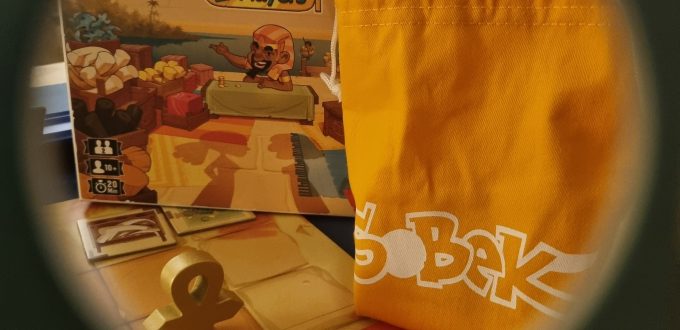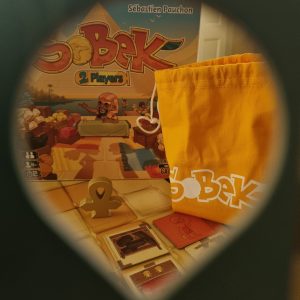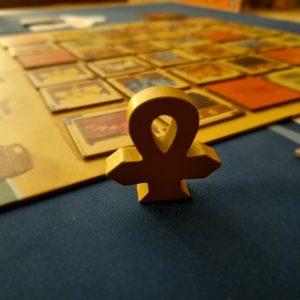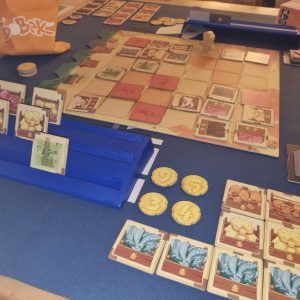Selling goods at the market is a profitable but risky, corrupt business in Bruno Cathala’s new 2 player tile laying version of Sobek!
Publisher: Catch Up Games, Hachette Board Games UK
Designer: Bruno Cathala, Sébastien Pauchon
Artist: Xavier Gueniffey Durin
Release date: 2021
2 Players
Age: 10+
20 mins
Favouritefoe score 8/10
*2 Player * Strategic * Simple Rules * Hand Management * Set Collection * Tile Laying * End Game Bonuses * Variable Set Up * Abstract * Strategy*
!Coo Coo For Cathala!
I confess. I’m a fangirl for the man from Les Montagnes. Scientist turned designer, his board games line my shelves. They have become cardboard friends which I can rely upon to give me a satisfying and soul warming session whenever they hit my table.
Five Tribes was the pivotal moment in my Cathala obsession. That game made my soul sing the moment I started dropping meeples all over the board. One game in and it went straight to the top of my favourites. And over a year later it hasn’t budged. Others are up there too; Kingdomino (literally all of them!), Abyss, Velomino, Trek 12…… the list goes on.
So when I saw Sobek 2 Player was a Bruno Cathala co-creation with his friend Sébastien Pauchon (aka the designer of Jaipur and others ), to say I was excited would be an understatement.
Question is; has it nestled into my shelves along with its Cathala cardboard buddies? Or is it the exception that proves the rule?
Read on to find out!
Goods Glorious Goods!
Sobek 2 player is a streamlined version of the original 2010 card game, Sobek. I should mention that I haven’t played that one so I can’t make any comparisons. But the setting of this version is super easy to dive into, and doesn’t seem to need any pre-existing knowledge.
In the game, you’re each competing market traders trying to snap up and sell the best goods. The central board represents Sobek market, and the goods are valued by the number of scarab beetles (0-3) shown on the goods tiles.
There are also some shady Characters lurking about who may be able to help you (or harm your opponent). But corruption flows freely under the surface at Sobek, and you will be penalised if you get too grabby for goods that are far away from the golden Ankh Pawn!
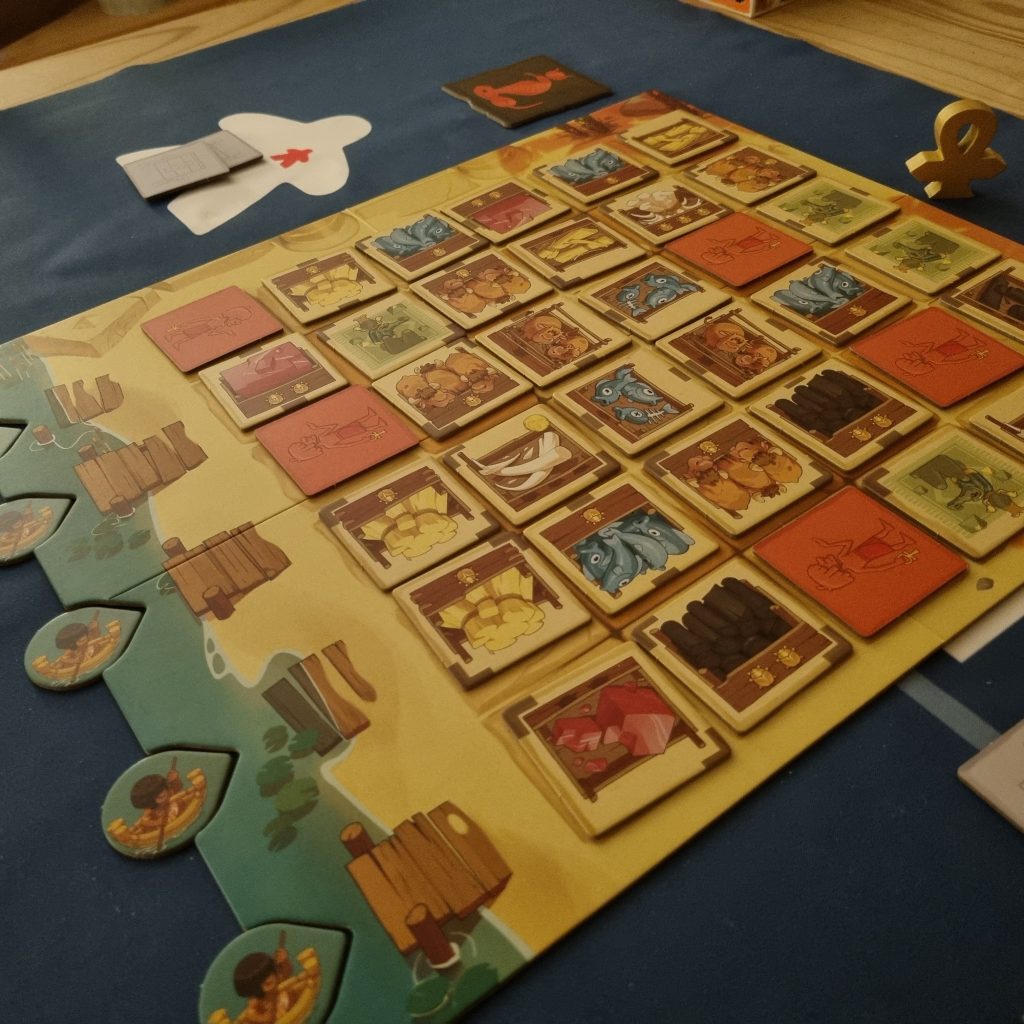
Setting Up Your Stalls!
Each game begins with a full central board – 36 market tiles in a 6 x 6 grid randomly selected from the pile. The central 4 tiles are always chosen randomly from the grey backed starting tiles. All goods tiles are flipped face up, whilst Character tiles remain face down. On the left side of the board are slotted 5 randomly selected Pirogue bonus tokens and the pile of deben coins, and each player gets a further two grey backed starting tiles into their hand as well as a corruption board.
On your turn, you pick up the gold Ankh Pawn and place it in one of the four central tiles, taking that tile into your hand. The Ankh Pawn, however, must be left such that it is orienteered to match the arrows shown on the tile you have just taken. This indicates the choice of tile available to the next player. Note that if you take a Character tile, you can choose which direction to point the Ankh Pawn.
If the next player takes the tile in the immediate line of sight to the Ankh Pawn’s orientation, there’s no price to pay. If they hop, skip and jump to a juicer one down the way, however, they have to take all the tiles they missed. These go on their corruption board which becomes important at end game scoring (but more on that later!).
When the Ankh Pawn is pointing to an empty diagonal or orthogonal row or column, the next player can refill the market with new randomly selected tiles if they want to take a tile on their turn. This is done in a circular pattern starting from the empty square closest to the middle. They then take one of the central four tiles again. If there are not enough tiles to refill all the empty spots, they fill using whatever tiles there are left and then leave the other spaces empty.
Instead of taking a tile into your hand, you might be able to take a tile but immediately convert it into a deben. Tiles that show a little coin symbol on them may be kept and used as part of a set later on, or traded in for a coin whose value will be revealed to others and counted at end game scoring.
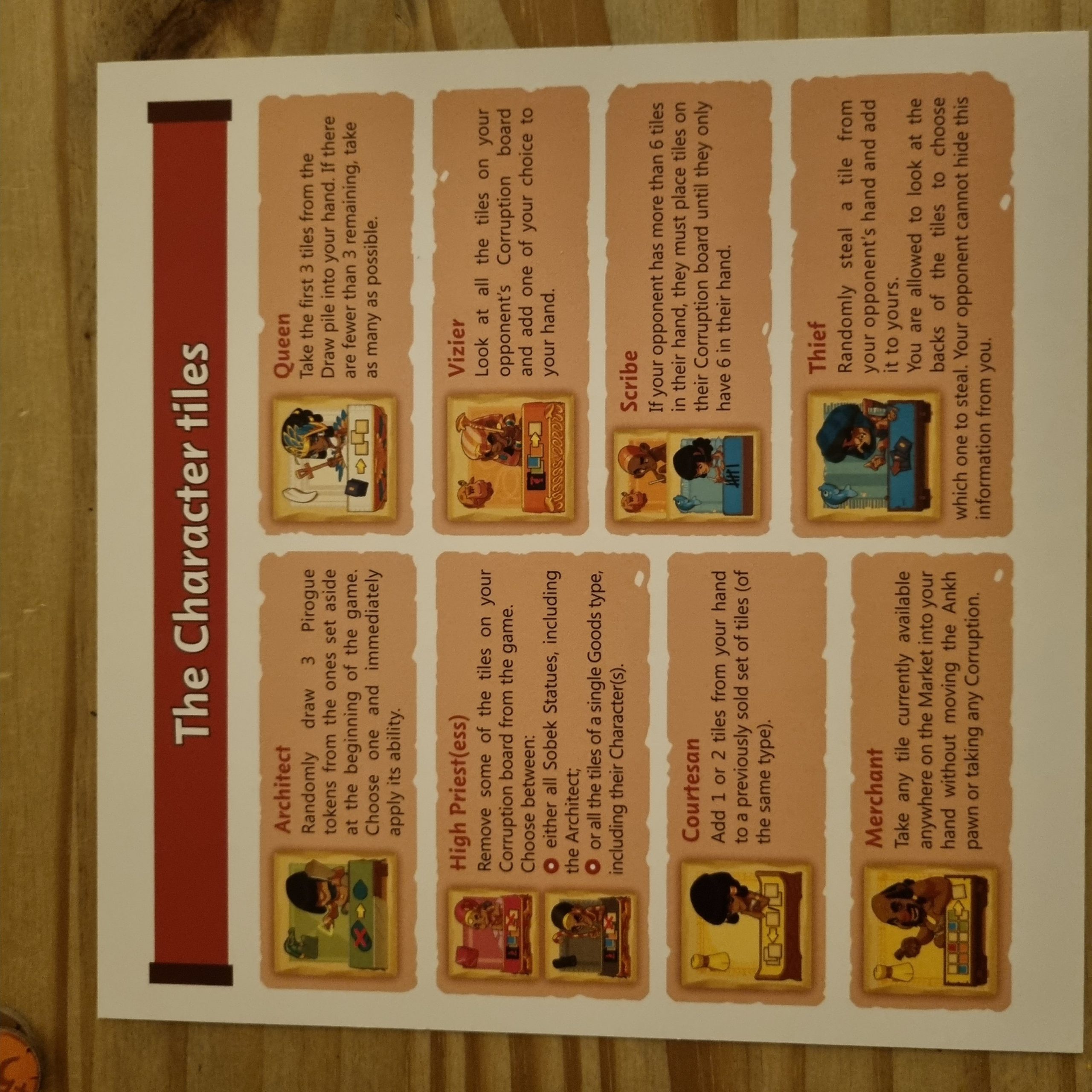
She’s So Shady!
If you don’t want to take a tile at all on your turn, you can play a Character so long as you have one in your hand. These have variable powers (including stealing tiles (Thief), taking any tile on the board (Merchant), adding tiles to a sold set (Courtesan) etc.). But they also represent a good of the colour type they show. And that can come in handy too if you want to sell some goods. After all, you’ll only get points in this game if you actually offload your wares!
And selling is where the set collection mechanism comes into play. Instead of taking a tile, you can sell a set of identical goods so long as you have at least three (formed of the goods themselves, wild statues, and/or Characters) in your hand at the start of your turn.
For Sale!
Having said that, you are only going to want to sell when your sets contain enough scarabs to make it worth your while. Scarabs act as value multipliers, so the more scarabs in your sets, the more they are worth. For example, having 3 bare wheat tiles would be a valid set, but it would score you zero. A set of 5 tiles showing a total of 3 scarabs would, in comparison, equal a fabulous fifteen points!
On the other hand, the first 5 sets sold each earn a bonus Pirogue token – these also award special powers (like forcing your opponent to take a specific tile on their turn, or granting you an extra turn etc.). So, strategically speaking, selling a set without scarab value may not be so worthless after all!
Play continues until a player can no longer take a tile or carry out an action, and then its point scoring time! As well as the points scored for the sets, you’ll be adding on any deben tokens you acquired during the game, as well as bonus deben tokens if you are the player with the least amount of corruption by the end of the game.

Bright Lights Of Sobek!
Okay so the artwork in Sobek 2 isn’t exactly a thing of great beauty. But it is fun and cartoony, and it doesn’t take itself too seriously. The drawstring bag is nice (we use it to store the tiles and give them a shuffle rather than hold the debens which we shuffle and stack), and the Ankh Pawn is a lovely chunky, wooden totem. The main board and market tiles themselves are also made from good quality, thick cardboard. The debens and the reference cards/score tracker are a wee bit thin, but they function fine. The rule book is also really clear and easy to read with lots of handy picture examples,
Favouritefoe hint: we have found using a tile/card holder from another game helps us to remember what we are collecting, as well as what Characters we have in our hand. The square tiles are nice but there are usually too many for me to hold. My memory is also terrible, and without a stand I am constantly flipping my own tiles up to see what I have got!
I am, however, a little disappointed that the goods in this game include ivory. The illegal trade of animal parts is not something I want to discuss in detail now. And although I am sure it was a nod to thematic or historical accuracy, even pretending to sell it for profit (and ultimately victory) leaves a little bit of a sour taste in my mouth (particularly as they are valued higher than all the other goods). In truth, I would have preferred it if they had substituted that commodity for another.
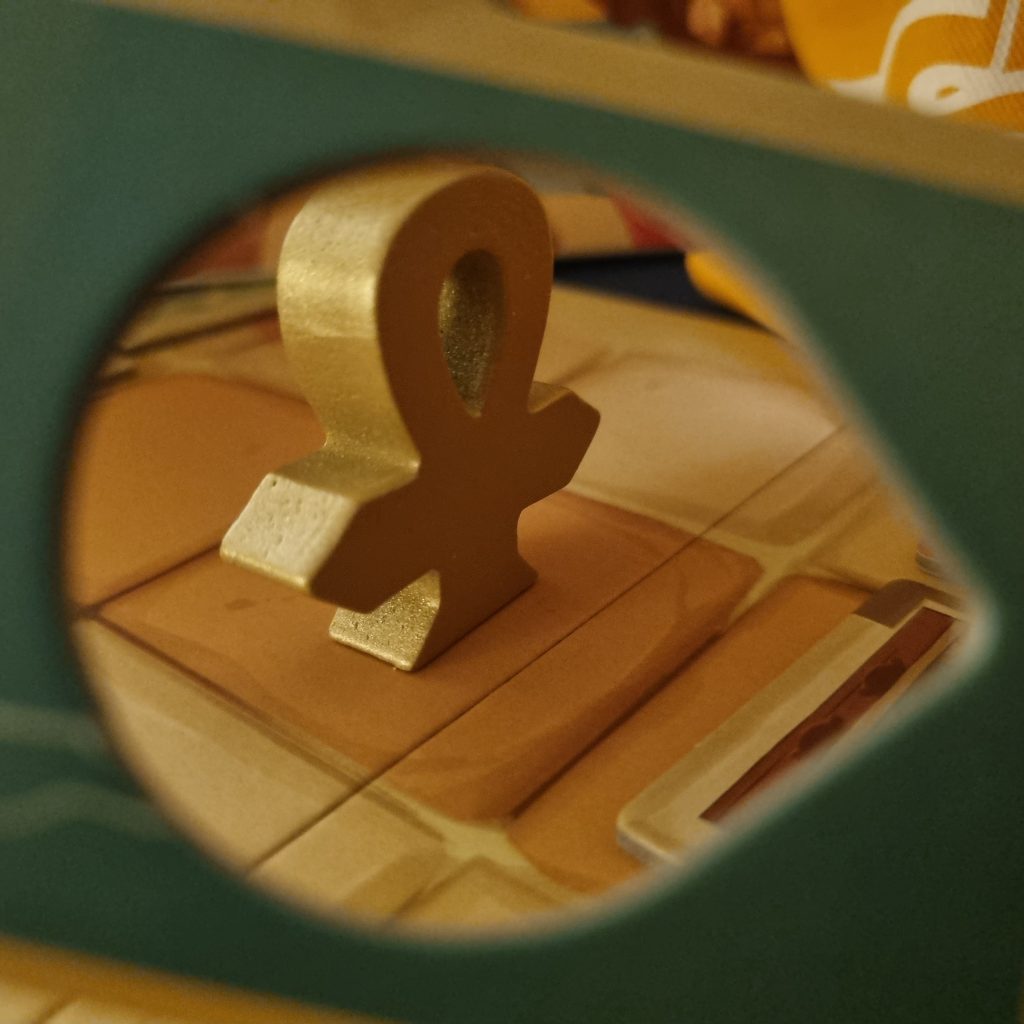
Time To Trade!
Sobek 2 Player is a fast playing game. Analysis paralysis may slow the turnaround time a little, but not by much. And when the Pawn is pointing to an empty row and there are no more replacement tiles or moves available, it’s all over! Indeed, due to the commination of moves taken, some games have gone by before we have even got into our selling stride!
But please don’t be fooled. This game is all about pace and timing. Even when the turns are racing by, you need to take stock. There might be a juicy 3 scarab tile in line of sight to the Ankh Pawn on your turn. You want it. You really want it. But if you take it now, asl yourself; “where will the Pawn point next?” Will it give your opponent something they really need? Something worth them taking a corruption hit for, even? Will it end the game before you have had a chance to sell a mega set? Will your opponent try to accelerate the end for the same reasons?
Knowing what your opponent is collecting and predicting what they will do with the opportunities your move gives them is key in this game. Taking tiles to set up sets is always tempting, but clever use of Characters at just the right time can be equally if not more effective long term. As the tiles run out towards the end of the game, some Characters lose their powers (e.g. the Queen), but they still represent goods which can preserve their value. And that decision making dilemma is not easy to deliver in a fast filler game. But Cathala and Pauchon have achieved it in this sandy, strategic tile taker!
The fact that the playing space remains dynamic and that your opponent has direct influence over what you can choose is a fresh take on set collecting. That loss of control might not suit everyone’s tastes, and the luck of the draw pile might worry some. But mitigating the effects using Characters, corruption, and trading brings a really good balance to the game.
With time, I anticipate that we will play the numbers more. Being aware of the specific distribution of tiles and scarabs amongst the different goods can be a tactical advantage. Indeed, ShadowmeepleMedia was pleasantly surprised by the think needed in such a simple looking game, and I love the combination of spatial puzzle and set collection. Overall, I am very glad to say that Cathala hasn’t disappointed me in Sobek 2. It is a fun filler with more crunch than meets the eye. And, as we always rate games that centre around messing with each other, Sobek 2 is a winner for us.

